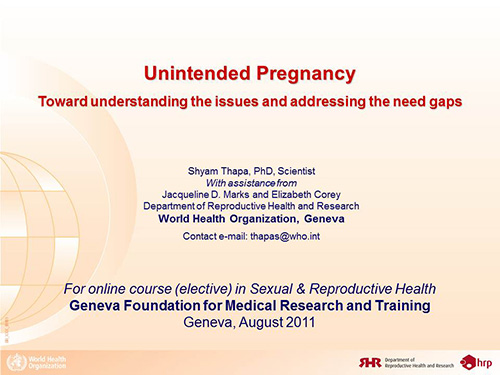Maternal and perinatal health - Course files
Unintended pregnancy. Toward understanding the issues and addressing the need gaps
Shyam Thapa
With assistance from Jacqueline Marks and Elizabeth Corey
From Research to Practice: Training Course in Sexual and Reproductive Health Research 2011
August 5, 2011 - Geneva
Download the complete document
Thapa S. Unintended pregnancy. Toward understanding the issues and addressing the need gaps. Paper presented at: Training Course in Sexual and Reproductive Health Research; 2011 Aug 5; Geneva. Available from: https://www.gfmer.ch/SRH-Course-2011/maternal-health/Unintended-pregnancy-Thapa-2011.htmSee also Unintended pregnancy. Toward understanding the issues and addressing the need gaps - Shyam Thapa (presentation with audio)
Key reading materials
- Barrett G, Smith SC, Wellings K. Conceptualisation, development, and evaluation of a measure of unplanned pregnancy. J Epidemiol Community Health. 2004 May;58(5):426-433.
- Barrett G, Wellings K. What is a “planned” pregnancy? Empirical data from a British study. Soc Sci Med. 2002 Aug;55(4):545-557.
- DiCenso A, Guyatt G, Willan A, Griffith L. Interventions to reduce unintended pregnancies among adolescents: systematic review of randomised controlled trials. BMJ. 2002 Jun 15;324(7351):1426.
- Fischer RC, Stanford JB, Jameson P, DeWitt MJ. Exploring the concepts of intended, planned, and wanted pregnancy. J Fam Pract. 1999 Feb;48(2):117-122.
- Gipson JD, Koenig MA, Hindin MJ. The effects of unintended pregnancy on infant, child, and parental health: a review of the literature. Stud Fam Plann. 2008 Mar;39(1):18-38.
- Higgins JA, Hirsch JS, Trussell J. Pleasure, prophylaxis and procreation: a qualitative analysis of intermittent contraceptive use and unintended pregnancy. Perspect Sex Reprod Health. 2008 Sep;40(3):130-137.
- Hubacher D, Mavranezouli I, McGinn E. Unintended pregnancy in sub-Saharan Africa: magnitude of the problem and potential role of contraceptive implants to alleviate it. Contraception. 2008 Jul;78(1):73-78.
- Kirby DB, Laris BA, Rolleri LA. Sex and HIV education programs: their impact on sexual behaviors of young people throughout the world. J Adolesc Health. 2007 Mar;40(3):206-217.
- Koenig MA, Acharya R, Singh S, Roy TK. Do current measurement approaches underestimate levels of unwanted childbearing? Evidence from rural India. Popul Stud (Camb). 2006 Nov;60(3):243-256.
- Koren A, Mawn B. The context of unintended pregnancy among married women in the USA. J Fam Plann Reprod Health Care. 2010 Jul;36(3):150-158.
- Otoide V, Oronsaye F, Okonofua F. Why Nigerian adolescents seek abortion rather than contraception: Evidence from focus-group discussions. International Family Planning Perspectives. 2001; 27: 77-81.
- Rosenfield JA, Everett K. Lifetime patterns of contraception and their relationship to unintended pregnancies. J Fam Pract. 2000 Sep;49(9):823-828.
- Santelli J, Rochat R, Hatfield-Timajchy K, Gilbert BC, Curtis K, Cabral R, Hirsch JS, Schieve L. The measurement and meaning of unintended pregnancy. Perspect Sex Reprod Health. 2003 Apr;35(2):94-101.
- Trussell J, Lalla AM, Doan QV, Reyes E, Pinto L, Gricar J. Cost effectiveness of contraceptives in the United States. Contraception. 2009 Jan;79(1):5-14.
Assignment
Depending on your interest, you can undertake all, some or none:
- Conduct a literature search on what is known about unintended pregnancies (UIPs) in your setting/country of interest and prepare a synthesis of the findings.
- Based on what is known, identify 3-5 key questions for further research in your country/setting.
- Develop a causal framework for analyzing unintended pregnancy (either unwanted or mistimed or both) as outcome/s of interest that includes contextual/intervening factors.
- Identify the "population" for your proposed study (third bullet, above) and develop a strategy for selecting women with unintended pregnancies. Discuss potential bias, if any, in the proposed sampling strategy.
- Assuming that you plan to do an in-depth interviews (IDI) with women (ages 16-20) who are attending a clinic, develop 8-10 guidance questions for the interview.
- Develop 10-12 guidance questions toward understanding reasons for not using contraception among pregnant women (ages 16-20) who have an unintended pregnancy.
- Assuming that you are interested in examining community values and norms regarding UIP through IDI with key informants, develop 6-8 questions for ascertaining community values and norms.
